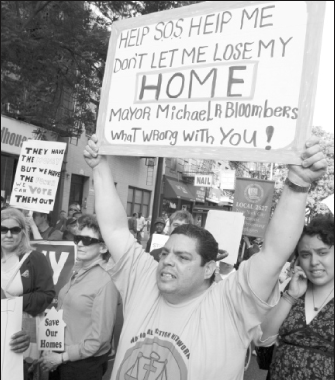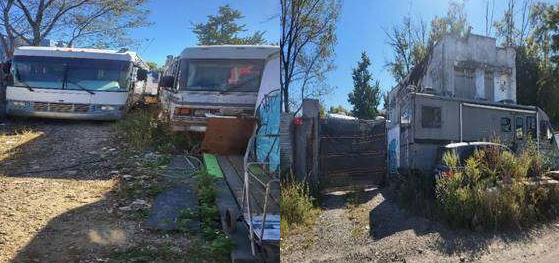By Alyssa Giachino
Few issues unite New Yorkers like the struggle for affordable housing, as was demonstrated by the thousands that gathered at Stuyvesant Town last Wednesday to decry climbing rents.
Tenants from Brooklyn, Queens and the Bronx joined hands with their Manhattan neighbors to encircle Stuy Town and Peter Cooper Village, demanding legislative action to expand affordable housing and protect rent-regulated units.
The human chain around Stuy Town turned into a march along 14th St. that reached Union Square. Organizers said the crowd exceeded 7,000, noting that the string of people extended back to Avenue C and 20th St. Police did not give a crowd estimate.
“New Yorkers want our elected officials to stop talking and do something to protect affordable housing,” said Julie Miles, director of Housing Here and Now, the event’s organizer. “I think the issue has reached a boiling point and tenants really turned out in force because Albany has really failed to take steps to protect the homes of more than 1 million people.”
Housing Here and Now is an umbrella group including dozens of housing organizations, the Central Labor Council and the Working Families Party.
More than 50 elected officials have signed on to Housing Here and Now’s campaign, and two dozen city and state representatives turned out at the march to show their support, saying repeatedly that having Governor Eliot Spitzer in office presents new opportunities to pass legislation.
State Senator Liz Krueger criticized Senate Republicans, namely Senate Majority Leader Joseph Bruno, for blocking housing bills in years past.
“While we dither and don’t pass legislation thousands of people lose their housing,” Krueger stressed.
The Housing Here and Now coalition is pushing a legislative agenda that includes removing vacancy-decontrol laws — which permit an apartment to go to market rate once it passes a $2,000 rent threshold. They are also advocating for greater protections for Mitchell-Lama tenants, including a moratorium on buyouts until tenant protections are adopted, such as giving tenants the first right to buy their own units.
State Senator Tom Duane led the crowd in chanting, “More control. Less rent.” He voiced support for other coalition agenda items, such as to “keep public housing public” by allocating adequate funding to existing public housing and to protect people living with AIDS by setting their rents at 30 percent of income.
“We have to make sure the next generation of New Yorkers can stay in this city and continue making it the greatest city in the world,” Duane said.
Manhattan Borough President Scott Stringer said action is urgently needed to keep New York City affordable.
“If the trend continues, we’re quickly becoming a city of the very, very wealthy with enclaves for the very poor and nothing in between,” he said.
Stuyvesant Town and Peter Cooper Village, with 11,250 apartments, was sold last October for a record-breaking $5.4 billion to Tishman Speyer Properties.
City Councilmember Daniel Garodnick, who represents the East Side complex, said, “Rent-stabilized tenants now live in a culture of fear.” Legal clinics to orient Stuyvesant Town and Peter Cooper Village tenants about their rights are packed, he said, due to fears the new owner will try to displace them in order to bring units up to market rate.
Alvin Doyle, president of the Stuyvesant Town Tenants Association, said that since the sale, the complex is losing affordable apartments weekly.
“These units need to be replaced,” he said, “if not in our community, in other communities.”
The association has also signed on to the coalition’s legislative agenda, and Doyle said that raising the vacancy-decontrol threshold would go a long way toward protecting affordability in Stuy Town.
The march was strengthened by the presence of hundreds of union members bearing placards and T-shirts representing a range of trades and professions from Teamsters to nurses, teachers and other city workers.
Edward Ott, who heads the city’s Central Labor Council, addressed the crowd, saying that labor’s gains over half a century are being eroded by the cost of housing.
“It’s intolerable that we have organized the city in such a way that the cost of living can’t be borne by two incomes,” he said.
“Unions and union members were out in force because they are feeling the squeeze like the rest of us are,” said Miles.
Housing Here and Now reports that between 2002 and 2005 average rents rose by 9 percent while tenant incomes fell by 6 percent. At the same time, the city’s subsidized affordable housing stock shrank by 11 percent. The organization released a study entitled “Losing Ground” to coincide with the march, which kicked off the campaign to reform housing laws.
Between 1994 and 2005, New York City lost more than 50,000 affordable units to high rent or vacancy decontrol, the report said. For families earning 80 percent of the city’s median income, between 2002 and 2005, around 205,000 apartments leapt out of their reach through rent increases, according to data from the Furman Center for Real Estate and Urban Policy.
Nina Sarna-Jones, a third grader who lives in Stuy Town, marched carrying a drawing of herself shouting from the window of her apartment tower, “I don’t like this!” Her grandmother Sally Jones said she’s concerned that her granddaughter’s parents might lose their apartment, which is close enough to Nina’s school that she can safely ride her bike there.
“I think it’s an important thing all over for the city to provide housing for all people,” Jones said.
Mae Lee, executive director of the Chinese Progressive Association, said finding affordable housing is a challenge for new immigrants, who often have limited opportunities to get into rent-protected units.
“What’s happening at Stuy Town, for other neighborhoods it’s bringing standards down,” she said.
Daniel Porro marched holding a sign over his head that read, “S.O.S! Help Me! Don’t let me lose my home.” He has diabetes and a bleeding ulcer, and his only source of income is a monthly Social Security check and $10 in food stamps.
“I am one check away from losing my apartment,” said Porro, who has lived in the same unit in the Bronx for 17 years. “My anger has turned me into an activist.”
A group of four teenagers huddled over a newspaper box as the march streamed past, scribbling a makeshift sign that read “Almighty Latin Kings for Housing.”
Wearing diamond studs in each ear and a Tupac T-shirt, Jonathan Davila, 19, said, “We are trying to lift up the Latino community.”
Davila, who lives in public housing on E. 104th St. and Lexington Ave., said the march gave him hope.
“It’s a lot of unity. That’s what we need the most,” he said. “It’s not a racial thing.”
“It was a really beautiful crowd,” said Miles, of Housing Here and Now, afterward. “It was a diverse gathering of people from every borough, of all ages. There were people with canes and walkers that stuck and made the march all the way to the end.”






































